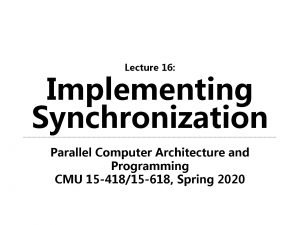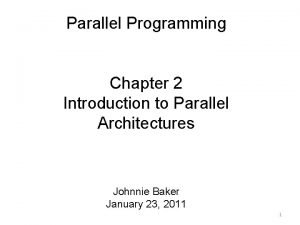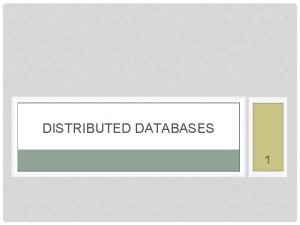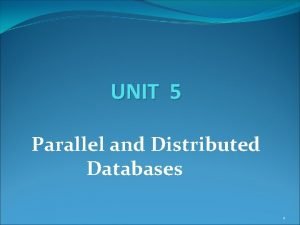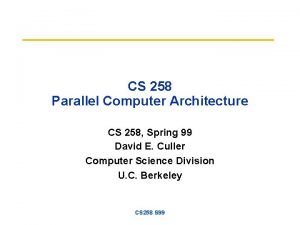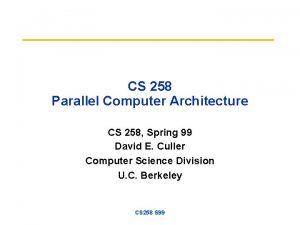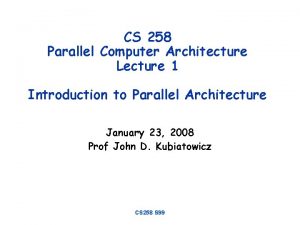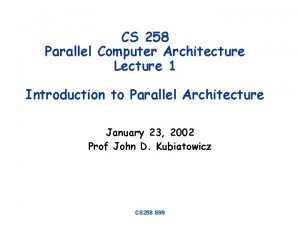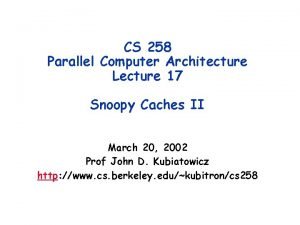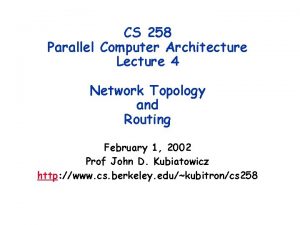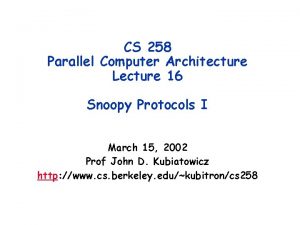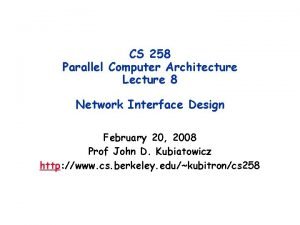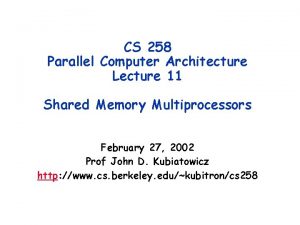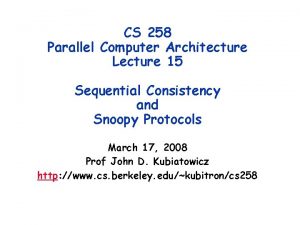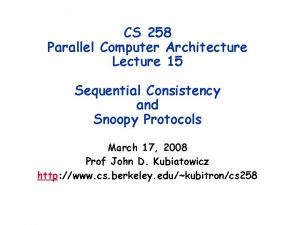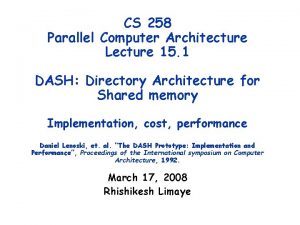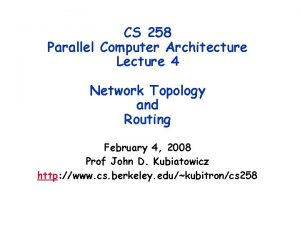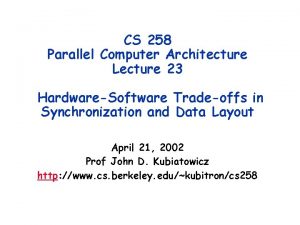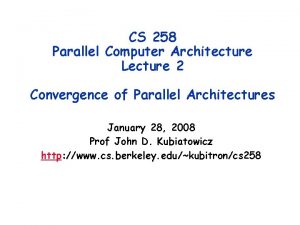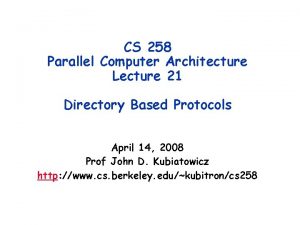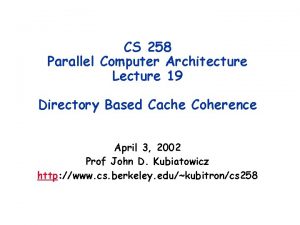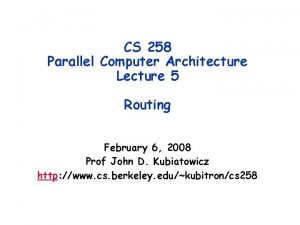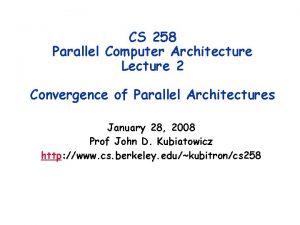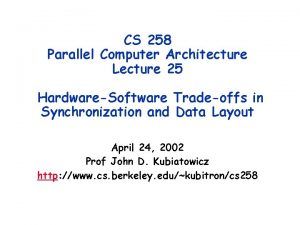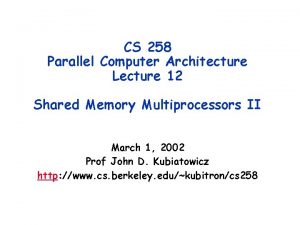CS 258 Parallel Computer Architecture Lecture 3 Introduction
































- Slides: 32

CS 258 Parallel Computer Architecture Lecture 3 Introduction to Scalable Interconnection Network Design January 30, 2008 Prof John D. Kubiatowicz http: //www. cs. berkeley. edu/~kubitron/cs 258

Scalable, High Perf. Network • At Core of Parallel Computer Arch. • Requirements and trade-offs at many levels – – Elegant mathematical structure Deep relationships to algorithm structure Managing many traffic flows Electrical / Optical link properties – – interactions across levels Performance metrics? Cost metrics? Workload? • Little consensus => need holistic understanding 1/30/08 Kubiatowicz CS 258 ©UCB Spring 2008 Lec 3. 2

Requirements from Above • Communication-to-computation ratio bandwidth that must be sustained for given computational rate – traffic localized or dispersed? – bursty or uniform? • Programming Model – protocol – granularity of transfer – degree of overlap (slackness) job of a parallel machine network is to transfer information from source node to dest. node in support of network transactions that realize the programming model 1/30/08 Kubiatowicz CS 258 ©UCB Spring 2008 Lec 3. 3

Goals • latency as small as possible • as many concurrent transfers as possible – operation bandwidth – data bandwidth • cost as low as possible 1/30/08 Kubiatowicz CS 258 ©UCB Spring 2008 Lec 3. 4

Outline • Introduction • Basic concepts, definitions, performance perspective • Organizational structure • Topologies 1/30/08 Kubiatowicz CS 258 ©UCB Spring 2008 Lec 3. 5

Basic Definitions • Network interface – Processor (or programmer’s) interface to the network – Mechanism for injecting packets/removing packets • Links – Bundle of wires or fibers that carries a signal – May have separate wires for clocking • Switches – connects fixed number of input channels to fixed number of output channels – Can have a serious impact on latency, saturation, deadlock 1/30/08 Kubiatowicz CS 258 ©UCB Spring 2008 Lec 3. 6

Links and Channels . . . ABC 123 => . . . QR 67 => Transmitter Receiver • transmitter converts stream of digital symbols into signal that is driven down the link • receiver converts it back – tran/rcv share physical protocol • trans + link + rcv form Channel for digital info flow between switches • link-level protocol segments stream of symbols into larger units: packets or messages (framing) • node-level protocol embeds commands for dest communication assist within packet 1/30/08 Kubiatowicz CS 258 ©UCB Spring 2008 Lec 3. 7

Clock Synchronization? • Receiver must be synchronized to transmitter – To know when to latch data • Fully Synchronous – Same clock and phase: Isochronous – Same clock, different phase: Mesochronous » High-speed serial links work this way » Use of encoding (8 B/10 B) to ensure sufficient highfrequency component for clock recovery • Fully Asynchronous – No clock: Request/Ack signals – Different clock: Need some sort of clock recovery? Data Transmitter Asserts Data Req 1/30/08 Ack t 0 t 1 t 2 t 3 t 4 t 5 Kubiatowicz CS 258 ©UCB Spring 2008 Lec 3. 8

Formalism • network is a graph V = {switches and nodes} connected by communication channels C Í V ´ V • Channel has width w and signaling rate f = 1/ – channel bandwidth b = wf – phit (physical unit) data transferred per cycle – flit - basic unit of flow-control • Number of input (output) channels is switch degree • Sequence of switches and links followed by a message is a route • Think streets and intersections 1/30/08 Kubiatowicz CS 258 ©UCB Spring 2008 Lec 3. 9

What characterizes a network? • Topology (what) • Routing Algorithm (which) • Switching Strategy (how) • Flow Control Mechanism (when) – physical interconnection structure of the network graph – direct: node connected to every switch – indirect: nodes connected to specific subset of switches – restricts the set of paths that msgs may follow – many algorithms with different properties » gridlock avoidance? – how data in a msg traverses a route – circuit switching vs. packet switching – when a msg or portions of it traverse a route – what happens when traffic is encountered? 1/30/08 Kubiatowicz CS 258 ©UCB Spring 2008 Lec 3. 10

Topological Properties • • 1/30/08 Routing Distance - number of links on route Diameter - maximum routing distance Average Distance A network is partitioned by a set of links if their removal disconnects the graph Kubiatowicz CS 258 ©UCB Spring 2008 Lec 3. 11

Interconnection Topologies • Class of networks scaling with N • Logical Properties: – distance, degree • Physical properties – length, width • Fully connected network – diameter = 1 – degree = N – cost? » bus => O(N), but BW is O(1) - actually worse » crossbar => O(N 2) for BW O(N) • VLSI technology determines switch degree 1/30/08 Kubiatowicz CS 258 ©UCB Spring 2008 Lec 3. 12

Example: Linear Arrays and Rings • Linear Array – – Diameter? Average Distance? Bisection bandwidth? Route A -> B given by relative address R = B-A • Torus? • Examples: FDDI, SCI, Fiber. Channel Arbitrated Loop, KSR 1 1/30/08 Kubiatowicz CS 258 ©UCB Spring 2008 Lec 3. 13

Example: Multidimensional Meshes and Tori 3 D Cube 2 D Grid • d-dimensional array – n = kd-1 X. . . X k. O nodes – described by d-vector of coordinates (id-1, . . . , i. O) • d-dimensional k-ary mesh: N = kd – k = dÖN – described by d-vector of radix k coordinate • d-dimensional k-ary torus (or k-ary d-cube)? 1/30/08 Kubiatowicz CS 258 ©UCB Spring 2008 Lec 3. 14

Properties of • Routing – relative distance: R = (b d-1 - a d-1, . . . , b 0 - a 0 ) – traverse ri = b i - a i hops in each dimension – dimension-order routing? Adaptive routing? • Average Distance Wire Length? • Degree? • Bisection bandwidth? Partitioning? – d x 2 k/3 for mesh – dk/2 for cube – k d-1 bidirectional links • Physical layout? – 2 D in O(N) space – higher dimension? 1/30/08 Short wires Kubiatowicz CS 258 ©UCB Spring 2008 Lec 3. 15

On Chip: Embeddings in two dimensions 6 x 3 x 2 • Embed multiple logical dimension in one physical dimension using long wires • When embedding higher-dimension in lower one, either some wires longer than others, or all wires long 1/30/08 Kubiatowicz CS 258 ©UCB Spring 2008 Lec 3. 16

Real Machines • Wide links, smaller routing delay • Tremendous variation 1/30/08 Kubiatowicz CS 258 ©UCB Spring 2008 Lec 3. 17

Administrivia • First set of readings posted for Monday – – 1/30/08 “The Future of Wires, ” Ron Ho, Kenneth W. Mai, and Mark A. Horowitz. “An Adaptive and Fault Tolerant Wormhole Routing Strategy for k-ary n-cubes, ” Daniel H. Linder and Jim C. Harden, Kubiatowicz CS 258 ©UCB Spring 2008 Lec 3. 18

Typical Packet Format • Two basic mechanisms for abstraction – encapsulation – fragmentation 1/30/08 Kubiatowicz CS 258 ©UCB Spring 2008 Lec 3. 19

Communication Perf: Latency per hop • Time(n)s-d = overhead + routing delay + channel occupancy + contention delay • Channel occupancy = (n + ne) / b • Routing delay? • Contention? 1/30/08 Kubiatowicz CS 258 ©UCB Spring 2008 Lec 3. 20

Store&Forward vs Cut-Through Routing Time: h(n/b + D/ ) vs OR(cycles): h(n/w + D) n/b + h D/ vs n/w + h D • what if message is fragmented? • wormhole vs virtual cut-through 1/30/08 Kubiatowicz CS 258 ©UCB Spring 2008 Lec 3. 21

Contention • Two packets trying to use the same link at same time – limited buffering – drop? • Most parallel mach. networks block in place – link-level flow control – tree saturation • Closed system - offered load depends on delivered – Source Squelching 1/30/08 Kubiatowicz CS 258 ©UCB Spring 2008 Lec 3. 22

Bandwidth • What affects local bandwidth? – packet density – routing delay – contention » endpoints » within the network b x n/(n + ne) b x n /(n + ne + w. D) • Aggregate bandwidth – bisection bandwidth » sum of bandwidth of smallest set of links that partition the network – total bandwidth of all the channels: Cb – suppose N hosts issue packet every M cycles with ave dist » each msg occupies h channels for l = n/w cycles each » C/N channels available per node » link utilization for store-and-forward: r = (hl/M channel cycles/node)/(C/N) = Nhl/MC < 1! » link utilization for wormhole routing? 1/30/08 Kubiatowicz CS 258 ©UCB Spring 2008 Lec 3. 23

Saturation 1/30/08 Kubiatowicz CS 258 ©UCB Spring 2008 Lec 3. 24

Organizational Structure • Processors – datapath + control logic – control logic determined by examining register transfers in the datapath • Networks – links – switches – network interfaces 1/30/08 Kubiatowicz CS 258 ©UCB Spring 2008 Lec 3. 25

Link Design/Engineering Space • Cable of one or more wires/fibers with connectors at the ends attached to switches or interfaces Narrow: - control, data and timing multiplexed on wire Synchronous: - source & dest on same clock Short: - single logical value at a time Asynchronous: - source encodes clock in signal 1/30/08 Long: - stream of logical values at a time Wide: - control, data and timing on separate wires Kubiatowicz CS 258 ©UCB Spring 2008 Lec 3. 26

Example: Cray MPPs • T 3 D: Short, Wide, Synchronous (300 MB/s) • T 3 E: long, wide, asynchronous (500 MB/s) – 24 bits » 16 data, 4 control, 4 reverse direction flow control – single 150 MHz clock (including processor) – flit = phit = 16 bits – two control bits identify flit type (idle and framing) » no-info, routing tag, packet, end-of-packet – 14 bits, 375 MHz, LVDS – flit = 5 phits = 70 bits » 64 bits data + 6 control – switches operate at 75 MHz – framed into 1 -word and 8 -word read/write request packets • Cray Black. Widow High-Radix Clos Network: long, narrow, mesochronous (800 MHz) – 3 bits each direction/port, 6. 25 Gbps per link, clock recovery – 64 ports – High-radix butterfly/fat tree network • Cost = f(length, width) ? 1/30/08 Kubiatowicz CS 258 ©UCB Spring 2008 Lec 3. 27

Switches 1/30/08 Kubiatowicz CS 258 ©UCB Spring 2008 Lec 3. 28

Switch Components • Output ports – transmitter (typically drives clock and data) • Input ports – synchronizer aligns data signal with local clock domain – essentially FIFO buffer • Crossbar – connects each input to any output – degree limited by area or pinout • Buffering • Control logic – complexity depends on routing logic and scheduling algorithm – determine output port for each incoming packet – arbitrate among inputs directed at same output 1/30/08 Kubiatowicz CS 258 ©UCB Spring 2008 Lec 3. 29

Properties of Routing Algorithms • Deterministic – route determined by (source, dest), not intermediate state (i. e. traffic) • Adaptive – route influenced by traffic along the way • Minimal – only selects shortest paths • Deadlock free – no traffic pattern can lead to a situation where no packets move forward 1/30/08 Kubiatowicz CS 258 ©UCB Spring 2008 Lec 3. 30

Deadlock Freedom • How can it arise? – necessary conditions: » shared resource » incrementally allocated » non-preemptible – think of a channel as a shared resource that is acquired incrementally » source buffer then dest. buffer » channels along a route • How do you avoid it? – constrain how channel resources are allocated – ex: dimension order • How do you prove that a routing algorithm is deadlock free? – More next time: See Linder and Harden reading 1/30/08 Kubiatowicz CS 258 ©UCB Spring 2008 Lec 3. 31

Summary Topology Degree Diameter Ave Dist Bisection D (D ave) @ P=1024 1 D Array 2 N-1 N/3 1 huge 1 D Ring 2 N/4 2 2 D Mesh 4 2 (N 1/2 - 1) 2/3 N 1/2 63 (21) 2 D Torus 4 N 1/2 2 N 1/2 32 (16) nk/2 nk/4 15 (7. 5) @n=3 n n/2 N/2 k-ary n-cube 2 n Hypercube 1/30/08 n =log N Kubiatowicz CS 258 ©UCB Spring 2008 10 (5) Lec 3. 32
 Computer architecture lecture notes
Computer architecture lecture notes Isa computer architecture
Isa computer architecture 258×203
258×203 Section 258 of mlrc
Section 258 of mlrc Emily dickinson 258
Emily dickinson 258 The verbs ser and estar (p. 258) answers
The verbs ser and estar (p. 258) answers Iis leonardo da vinci roma
Iis leonardo da vinci roma Rd 258/99
Rd 258/99 Gog 258
Gog 258 01:640:244 lecture notes - lecture 15: plat, idah, farad
01:640:244 lecture notes - lecture 15: plat, idah, farad Parallel computer architecture cmu
Parallel computer architecture cmu Types of interrupt in computer organisation
Types of interrupt in computer organisation Bus architecture in computer organization
Bus architecture in computer organization Computer organization and computer architecture difference
Computer organization and computer architecture difference Basic computer organization and design
Basic computer organization and design Introduction to computer organization and architecture
Introduction to computer organization and architecture Cloud computing lecture
Cloud computing lecture Computer security 161 cryptocurrency lecture
Computer security 161 cryptocurrency lecture Computer-aided drug design lecture notes
Computer-aided drug design lecture notes Introduction to biochemistry lecture notes
Introduction to biochemistry lecture notes Introduction to psychology lecture
Introduction to psychology lecture Introduction to algorithms lecture notes
Introduction to algorithms lecture notes Like parallel forces example
Like parallel forces example The approximate center of a pattern is called
The approximate center of a pattern is called Parallelism
Parallelism Parallel sentence structure
Parallel sentence structure Mary likes hiking swimming and to ride a bicycle
Mary likes hiking swimming and to ride a bicycle 4 bit shift register
4 bit shift register Parallelism meaning and examples
Parallelism meaning and examples Types of parallel architecture
Types of parallel architecture Parallel and distributed database architecture
Parallel and distributed database architecture Parallel and distributed database architecture
Parallel and distributed database architecture Parallel processing definition
Parallel processing definition










